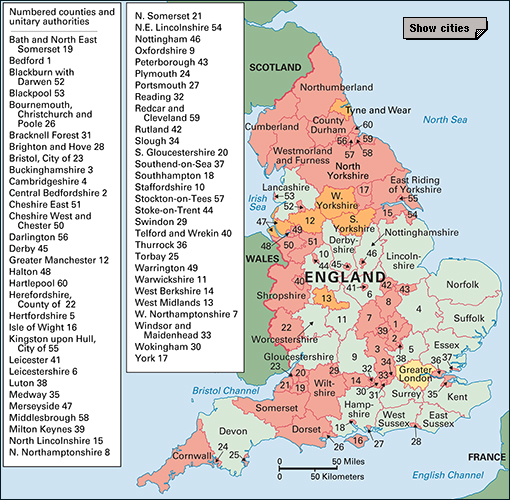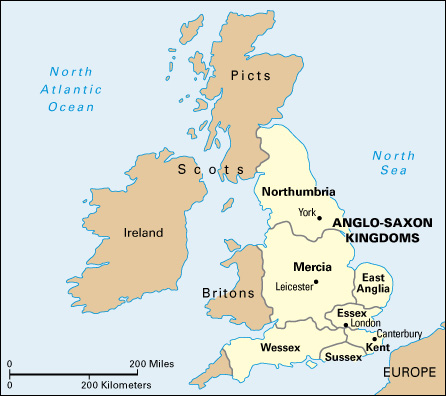Essex (pop. 1,503,521) is a county in southeastern England. Its name comes from the name of an early Anglo-Saxon group called the East Saxons. The kingdom of the East Saxons was established in the area in the A.D. 400’s. Several Saxon churches, dating from the 600’s onwards, still survive in Essex. There are several towns in the county, but much of it retains a rural character.

Until April 1965, a densely populated area of northeastern London lay within the boundaries of Essex. But this area was transferred from Essex to Greater London. As a result, Essex lost a small fraction of its area and more than half of its population. The area that was transferred became the London boroughs of Barking and Dagenham, Havering, Newham, Redbridge, and Waltham Forest.
The University of Essex is in Wivenhoe Park, at Colchester. It admitted its first students in 1964. Anglia Polytechnic University, in Chelmsford, became a university in 1992. There are colleges of further education at Basildon, Braintree, and Loughton, and technical colleges at Harlow and Thurrock. Other technical colleges are at Chelmsford and Colchester, and they have schools of art attached to them. Loughton has a school for actors, and an agricultural college is located at Writtle, near Chelmsford.
People and government
Customs.
Essex is famous for oysters, and two annual festivals are associated with them. Each September, the mayor and council of Colchester wear their ceremonial gowns and sail out to Pyefleet Creek. There they proclaim that Colchester’s oyster fishery is open for fishing. In October, the people hold an oyster feast, entertaining distinguished guests invited by the mayor.
One of the county’s oldest customs is the trial for the Dunmow Flitch. A side of bacon is awarded to the couple who can prove to a jury of unmarried men and women the happiness of their marriage.
Recreation.
Essex has a first-class county cricket team and a soccer team that plays in the Football League. The county has good facilities for water sports, such as swimming, sailing, and fishing. Many sea birds shelter on the river estuaries. More than 1,000 species of plant have been recorded in the county.
Local government.
Essex is divided into 12 administrative districts: Basildon, Braintree, Brentwood, Castle Point, Chelmsford, Colchester, Epping Forest, Harlow, Maldon, Rochford, Tendring, and Uttlesford. Essex County Council, which has headquarters at Chelmsford, provides some public services throughout the county. In 1998, Southend-on-Sea and Thurrock became unitary authorities with all local government powers within their boundaries.
Basildon and Harlow are new towns, planned for rapid growth, particularly as overspill towns providing homes and jobs for people who have moved out of overcrowded parts of neighboring London. Chelmsford is the location of the Essex police headquarters, and is the meeting place for the crown court.
Economy
Manufacturing.
Essex is an important business location. The main manufacturing centers are Basildon, Braintree, Chelmsford, Colchester, Harlow, and Witham. The largest employer in the county is the electronics industry, which has major centers at Basildon, Chelmsford, and Harlow. Basildon is also a center for the motor vehicle industry, and the town has factories producing cosmetics, tractors, and air-conditioning equipment. Chelmsford also produces packaging and soft drinks, while Harlow specializes in pharmaceuticals, glass, and printing and publishing.
Colchester is a center for mechanical engineering, including diesel engines, industrial fans, and water screening plant, as well as printing and materials for publishing and packaging.
Essex has had a textile industry since the 1300’s. Originally, it was based on wool, but now it produces mainly synthetic fibers at Halstead. Brewing is an important Essex industry, and malt for the breweries is produced locally. Bradwell-on-Sea has a nuclear power station.
Agriculture.
Farming has traditionally been important in Essex. Before the 1960’s, Essex was a county of mixed farming, producing barley, dairy cattle, hogs, poultry, root crops, sheep, sugar beet, and wheat. During the 1960’s, extensive field enlargement allowed more intensive production, and Essex became predominantly a cereal-producing county. But the trend toward large-scale cereal production has been reversed, and today farmers also grow oil seed rape, potatoes, and vegetables, as well as rearing goats, hogs, poultry, and sheep.
In southern and western Essex, market gardeners produce vegetables for the London market. Fruit growing and jam making are important in the Tiptree area and to the north of Colchester.
Mining.
Essex has extensive deposits of sand and gravel which are extracted in a number of locations.
Tourism.
Tourism plays an important part in the Essex economy. The major seaside resort of Clacton-on-Sea, together with the smaller resorts of Frinton-on-Sea, Holland-on-Sea, and Walton on the Naze, have traditionally attracted most visitors. More recently, towns such as Colchester and Saffron Walden have grown in popularity, as have the county’s many historic buildings, forests, and country parks.
Transportation and communication.
Southern Essex has railroad connections with London. A number of main roads in Essex radiate from London, including the M11 highway in the west of the county and the A12, which runs northeast through Chelmsford and Colchester. The A120 runs east-west from Harwich.
The main Essex port is Harwich, which is part of the Port of London. Harwich specializes in cargo for the European mainland. Essex has two airports. Stansted, London’s third airport, has regular scheduled flights to Europe and the United States. Southend has chartered flights to Europe.
Land and climate
Location and size.
Essex is bounded by Suffolk on the north side, the North Sea on the east, London on the southwest, Hertfordshire on the west, and Cambridgeshire on the northwest. The River Thames, Greater London, and the unitary authorities of Southend-on-Sea and Thurrock lie to the south. The longest distance in Essex from north to south is 42 miles (68 kilometers). The longest distance from east to west is 50 miles (80 kilometers).
Land features.
Most of Essex is low lying, with marshy areas along the coast and the Thames estuary. Forests once grew over about one-tenth of the county. But, today, the only large forest is Epping Forest, in southwestern Essex. Epping Forest is the remnant of what was once a large royal hunting ground of Saxon, Norman, and Tudor monarchs. Roe deer and fallow deer can still be seen in the forest.
The coastline of Essex is broken by the estuaries of the Blackwater, Colne, and Crouch rivers, and by many winding creeks. Marshy islands lie off the coast, providing habitats for many kinds of birds, such as wild geese and curlews. The empty coastlands are also rich in wild flowers, including the golden samphire, the sea aster, the sea holly, and the sea lavender.
Rivers.
The Blackwater, Colne, Crouch, and Stour rivers flow into the North Sea. The River Crouch is about 35 miles (55 kilometers) long. The River Lea and its tributary, the Stort, form part of the western boundary of Essex.
Climate.
The average rainfall throughout Essex is less than 26 inches (66 centimeters per year). Much of the rain falls during summer thunderstorms. In most of the county, July temperatures average between 61° and 63 °F (16° and 17 °C). January temperatures in Essex average between 37° and 39 °F (3° and 4 °C).
History
The Trinobantes, a powerful tribe of ancient Britons, lived in Essex before the Roman invasions. The chief settlement of the Trinobantes was Camulodunum (present-day Colchester). In 54 B.C., a Roman army defeated the Trinobantes. The Romans established a colony at Camulodunum in A.D. 44, after their second invasion of Britain. Seventeen years later, Boudicca (also spelled Boadicea) led a rebellion against the Romans. But the Romans reconquered the area and remained until the 400’s.

In 823, Essex was incorporated into Wessex (see Wessex). The Danes began their raids on Essex in 870. They established a camp on Mersea Island and quickly occupied the rest of Essex. The whole county had become part of the Danelaw (the area under Danish rule) by 885.
The Normans occupied Essex in the late 1000’s. They seized the property of many landowners and built castles with which to dominate the land. They also encouraged the spread of Christianity and introduced improved farming methods.
Essex became important in the 1300’s and 1400’s for its wool industry. Many Huguenot refugees settled in Essex in the 1600’s after they had lost their political freedom in France. The Huguenots were skilled textile workers, and they helped to improve the wool industry in the county. But the industry declined after the changes brought by the Industrial Revolution.
In 1620, the first pilgrims traveled to America in the Mayflower (see Mayflower). The captain of the ship came from Essex. Historians estimate that about half of the early settlers in New England had associations with Essex. The English Quaker, William Penn, who founded the state of Pennsylvania in the United States, was educated at Chigwell School in Essex. Chigwell School, one of several long-established private schools in Essex, was founded in 1629.
Many other well-known people have lived in Essex. John Locke, the philosopher, was buried at High Laver in 1704. William Harvey, who discovered how blood circulates in the human body, lived in Hempstead. William Gilbert, who made the first scientific study of magnetism, was born in Colchester. Dick Turpin, the highwayman of the 1700’s, was born at Hempstead, southeast of Saffron Waldon.
